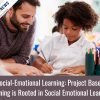Teaching & Learning: Does a quiet classroom quietly harm children?
This article is republished with permission from IntrepidEd News
Richard Wells
I was talking to a teacher this week and he was telling me stories of how exciting it had been to see a student teacher working with his class. It was that fresh enthusiasm and excitement new teachers can have towards experimenting with the variety of things that can be done in a classroom. The point he was making was how in the short number of years he had been teaching he had to admit that he had narrowed the variety of experiences in his classroom down to a set of activities that ensured the class were calm / quiet, and kept busy with their individual copies of the issued task.
From the outside, his classroom looked like a well-meaning, focused, orderly affair and would tick the core requirements of the job. This quiet and orderly environment had also become the classroom norm for the students. The teacher highlighted that issuing individual ‘busy work’ and/or teaching the whole class from the front were the easy parts of the job and other forms of activity meant more workload.
This chat coincided with an encouragement I had offered to all of the teachers in my school to look at the variety of activities they generally utilised in the classroom and look to expand these, especially those that encourage students to speak to each other about the learning or to tackle learning challenges together. I highlighted that into many high school situations, the social aspect of being in the classroom was too often reduced to what a student referred to as “sitting with my friend and chatting with my friend while we each do our own (busy) work.” I had confirmed in discussions with students throughout the week that rarely were high school students instructed to work with others on something but it was extremely rare that they were challenged to work with somebody who wasn’t already their friend.
During the week, I visited five morning Form classes, who spend the first 20 minutes of each day together for administrative tasks such as attendance and notices. In each of these Form classes I found that after spending more than two years of mornings together, I could find a student in the room who could not name a person on the other side of the room. In fact, some looked surprised that I expected them to know a peer’s name. The experience of school had made it so unusual and uncomfortable to say hello to somebody you didn’t already know, it just wasn’t an expectation that you would. This made me think of all the lonely students in high school who find a safe spot to sit alone every lunchtime, confirming that not only can you be lonely at school but you wouldn’t expect any of the 1000 people around you to say hello.
I wonder if this issue also has implications on bullying in schools. The isolated individuals and cliques of students that, through a lack of communication and social practice, act on rumour and assumptions, causing individual and group bullying scenarios.
There is a common temptation to say that this is what teenagers are like but my dealings with teenagers who for various reasons spend their teens outside conventional high schooling classrooms challenges this idea. I have found students schooled via Project-based schools, homeschooling, or even conventional students who happen to engage in numerous external clubs and teams are often found to not be so alien to the idea of saying hello and introducing themselves to a stranger. It seems to me to be the daily classroom ‘training’ that produces people who don’t expect to speak or work with strangers until they leave school. The unsocial expectations of most moments in the classroom even dampens the behaviour of students who outside the classroom are comfortable introducing themselves to strangers.
The implications of not regularly (weekly) practising ‘working with others’ stretch far and wide. Through a lack of experience, it becomes self-fulfilling that the students don’t want to speak to others or even say hello and so teachers excuse themselves from having to make it part of the classroom / school experience as a teacher highlighted “There’s no point mixing them up, the teens hate it.” This becomes a self-perpetuating downward spiral away from the most important skills for getting the most out of life and entering the world of work with a level of self-confidence and confidence with others.
I think every classroom and school has a duty to this generation in particular, who spend so much time isolated on their phones and online to make it a weekly, if not daily, norm to say hello to somebody new and look to work on something together. The challenge to my high school’s staff was to just choose one lesson per two-week timetable so that across subject areas every student might have 15% of lessons where the class is mixed-up and speaking to others is normalised. In a short space of time, this regular practice during learning can change expectations and remove the fear and anxiety towards meeting, greeting, and working with anyone you’re with at any time.
If you are a teacher, consider how many times this week you asked students to work with different peers and how you could build up a library of not only learning-based structured group activities but importantly a separate library of short 60 second icebreakers to help them with vital basic social skills in saying hello, introducing themselves and finding more connections between their peers. My instant starter tip was to any Kahoot users to use Team-mode rather than Individual-mode. This auto mixes up the class into quiz teams but don’t forget that important 60 second icebreaker, otherwise they won’t say hello.
Let’s be strategic as educators in normalising learning as the social experience it should be.


















Add comment